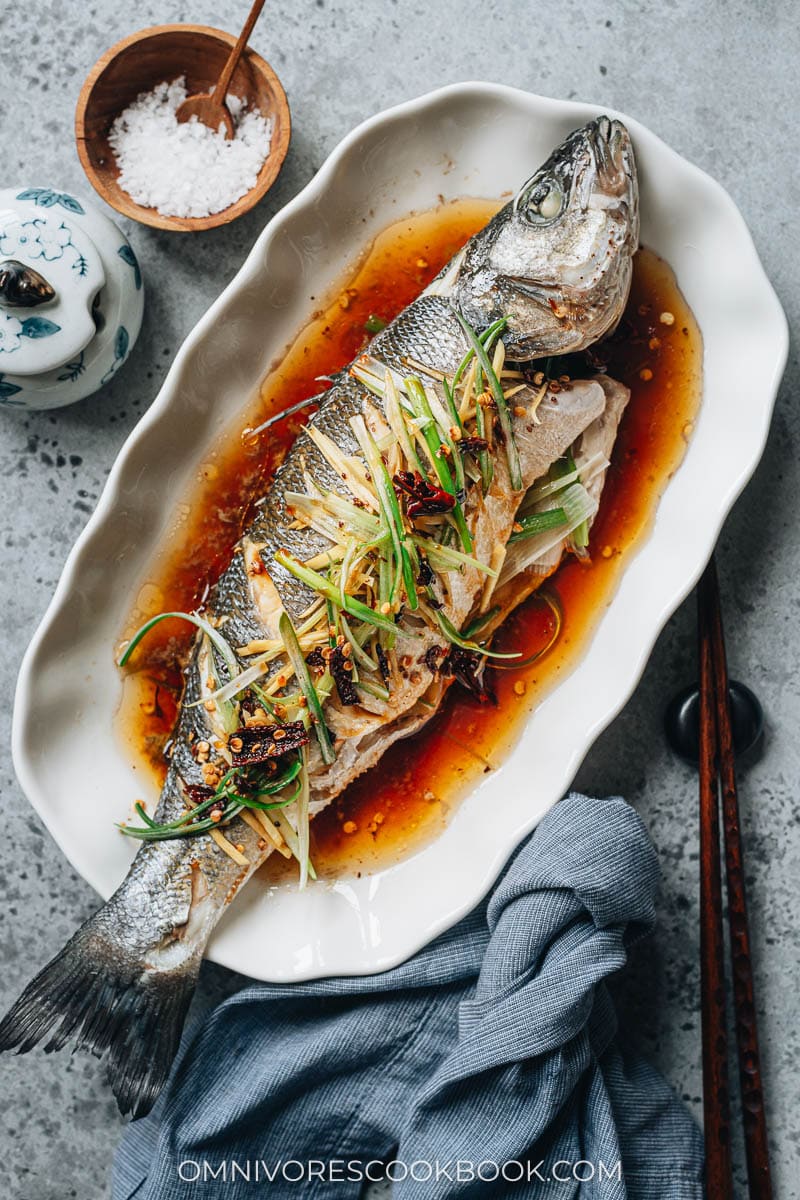
Steamed whole fish is a classic dish in Chinese home cooking. It uses very few ingredients to bring out the great flavor of fresh fish.
Stuffed with ginger and green onion, the whole fish is steamed until flaky, tender, and juicy. It’s then quickly seared with an aromatic infused hot oil that makes the fish extra fragrant, and served with seasoned soy sauce.
The fresh ginger and green onion help eliminate any fishiness. The seasoned soy sauce adds a bit of sweet and savory umami to the dish. The fish is cooked in a steamer for the shortest amount of time, so that the finished meat is silky, tender, and moist.
Steamed fish is also a dish that represents wealth and good fortune. In Chinese, the character for fish (鱼, yu) has the same pronunciation as that for “surplus” (余, yu), which indicates that a family has a surplus of wealth and food at the end of the year. For a lot of families, steamed fish is a must-have on the dinner table for Chinese New Year. And when going to a restaurant with a group of friends or gathering for any celebration, steamed fish is a go-to dish.
Steamed fish is a very simple dish that requires very little time to put together. Check out my video and step-by-step photos below to see how easy it is to make it.
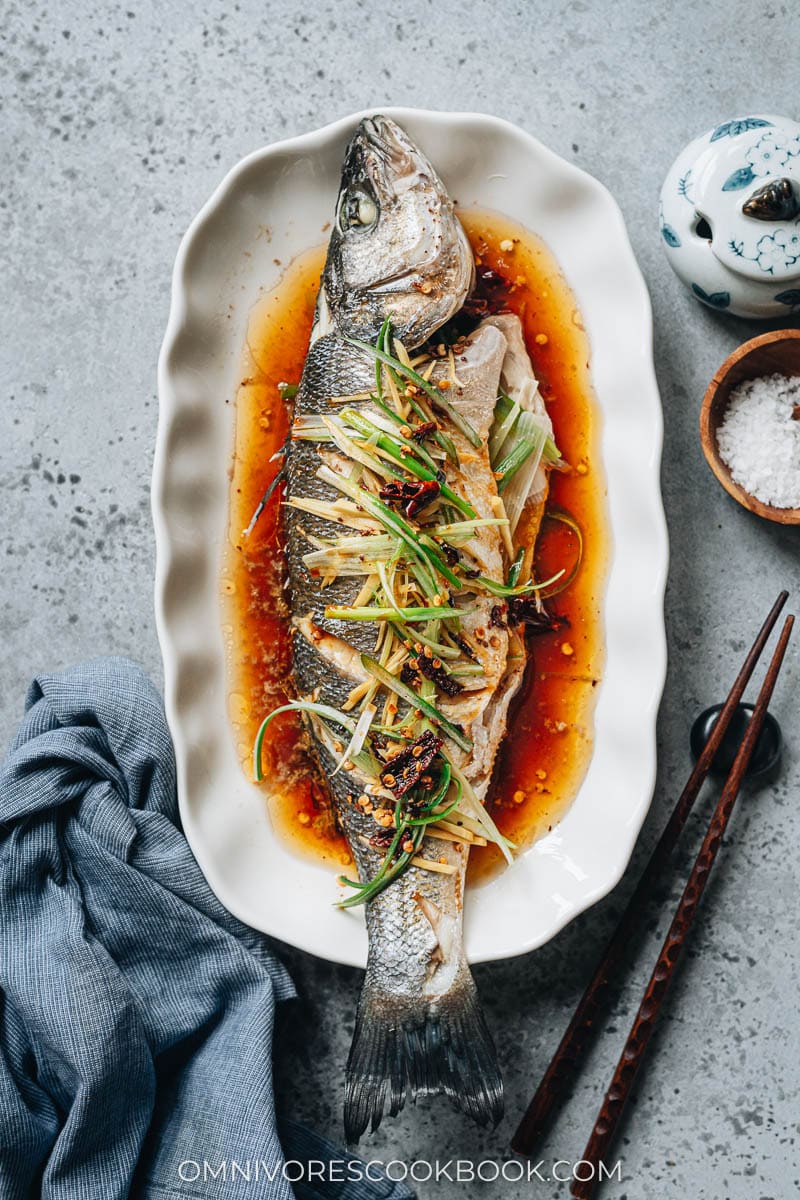
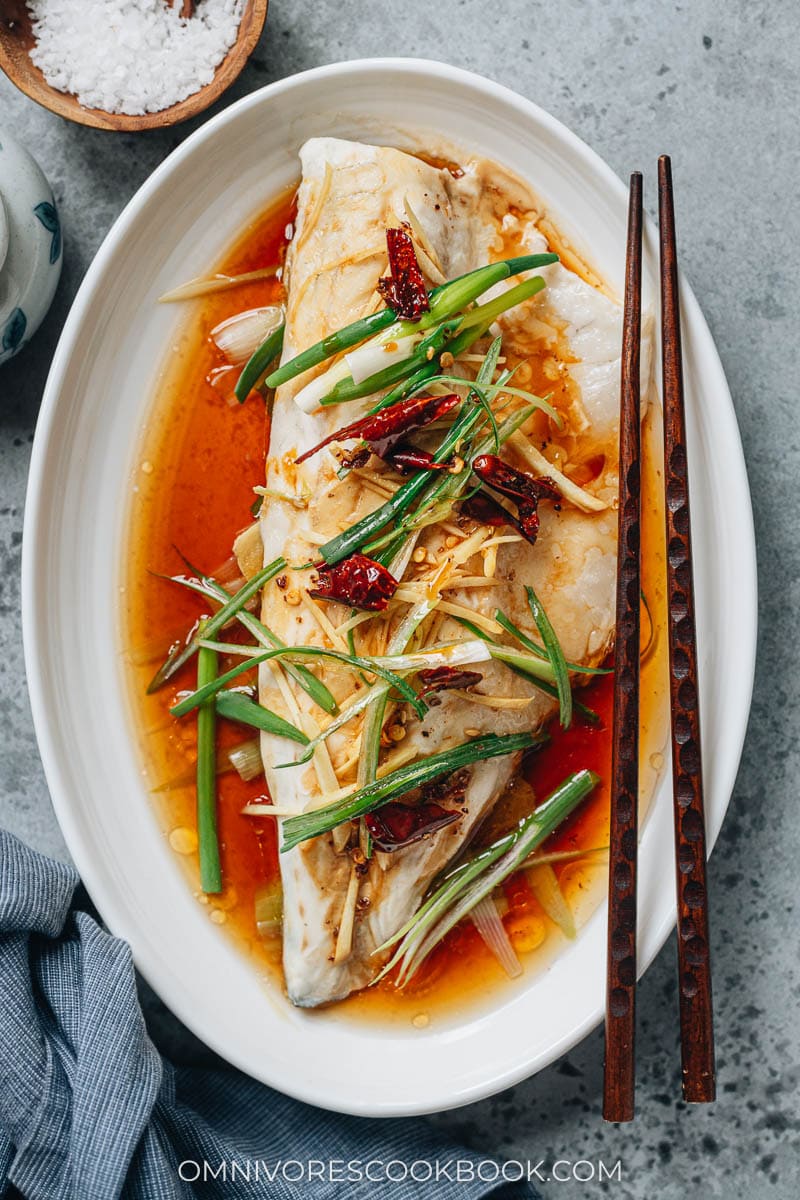
Steamed fish ingredients
How to select fish for Chinese steamed fish
The best fish for Chinese steamed fish is a (recently) live fish. The next best is a fresh whole fish. You can always use a fish filet, but I highly recommend trying this one with a whole fish if you can.
If using a whole fish, you can usually find it at a Chinatown market or a large Chinese grocery store. When you purchase the fish, have it gutted and scaled at the counter to save you some work.
You can also purchase a fresh whole fish at a large grocery store with a fish counter. If the fish is fresh, it will have clear eyes and metallic scales. It shouldn’t have a fishy or stinky smell.
It’s important to choose a small fish, which will cook faster and taste juicier. And you also need to make sure that your steamer (or whatever cookware you plan to use) can hold the fish. Try to select a fish that is around 1 lb (500 g). Do not select a fish that is heavier than 1.5 lb (700 g). This dish uses minimal seasoning and cooking. The bigger the fish, the tougher and thicker the flesh, which will result in a flakier, tougher texture.
I used branzino in my recipe, which is quite a popular fish in the US these days, and rather easy to find. Other white fish such as flounder and tilapia work as well.
If using a fish filet, you have a wider range of varieties to choose from. For example, snapper and cod would work well.
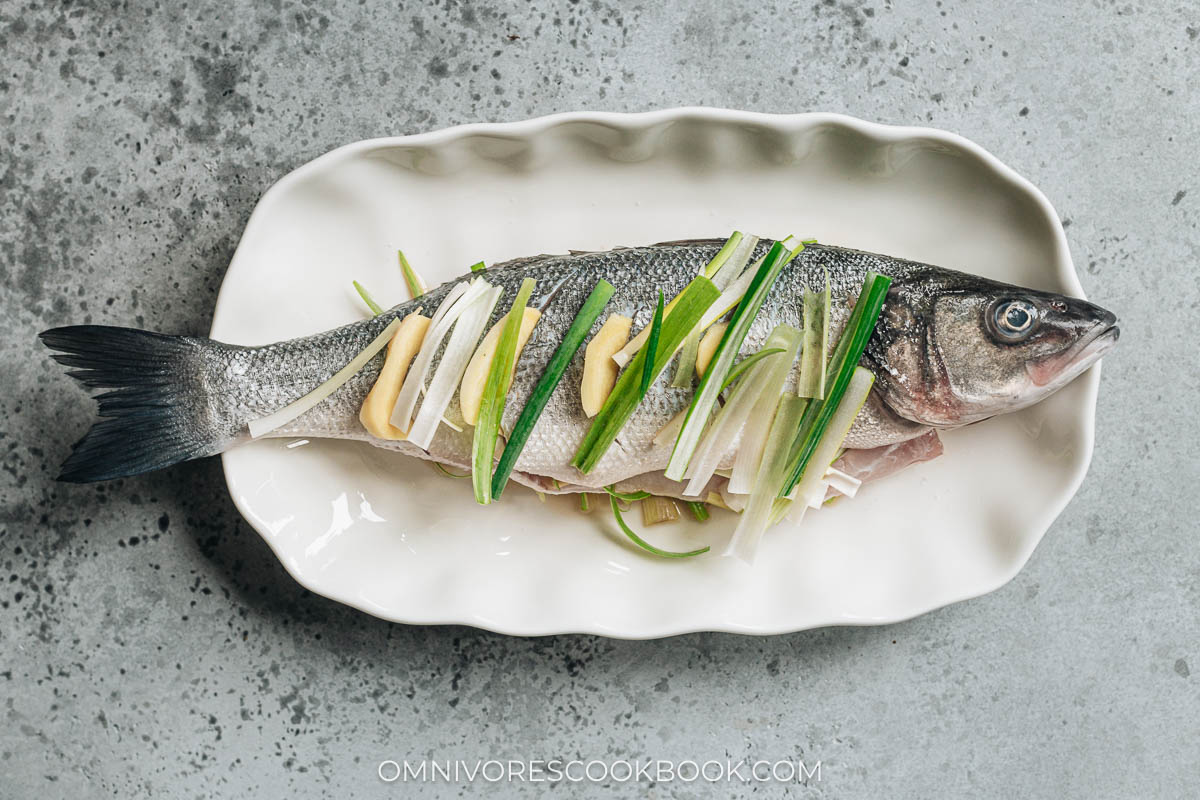
Seasoned soy sauce
The main seasoning in this dish is seasoned soy sauce (蒸鱼豉油, Zheng Yu Chi You). It’s a type of soy sauce that is seasoned with sugar and MSG. This ingredient is pretty much specifically formulated for Chinese steamed fish. If you do not wish to purchase it, you can also make your own seasoned soy sauce using regular soy sauce, sugar and a pinch of chicken bouillon.
You can purchase seasoned soy sauce at Chinese grocery stores or on Amazon.

Mise en place
Chinese steamed fish requires just seven ingredients and is quite easy to prep. It includes:
- A whole fish (or fish filet)
- Ginger (sliced and julienned)
- Sliced green onion
- Seasoned soy sauce
- Shaoxing wine
- Dried chili pepper
- Sichuan peppercorns (Optional)
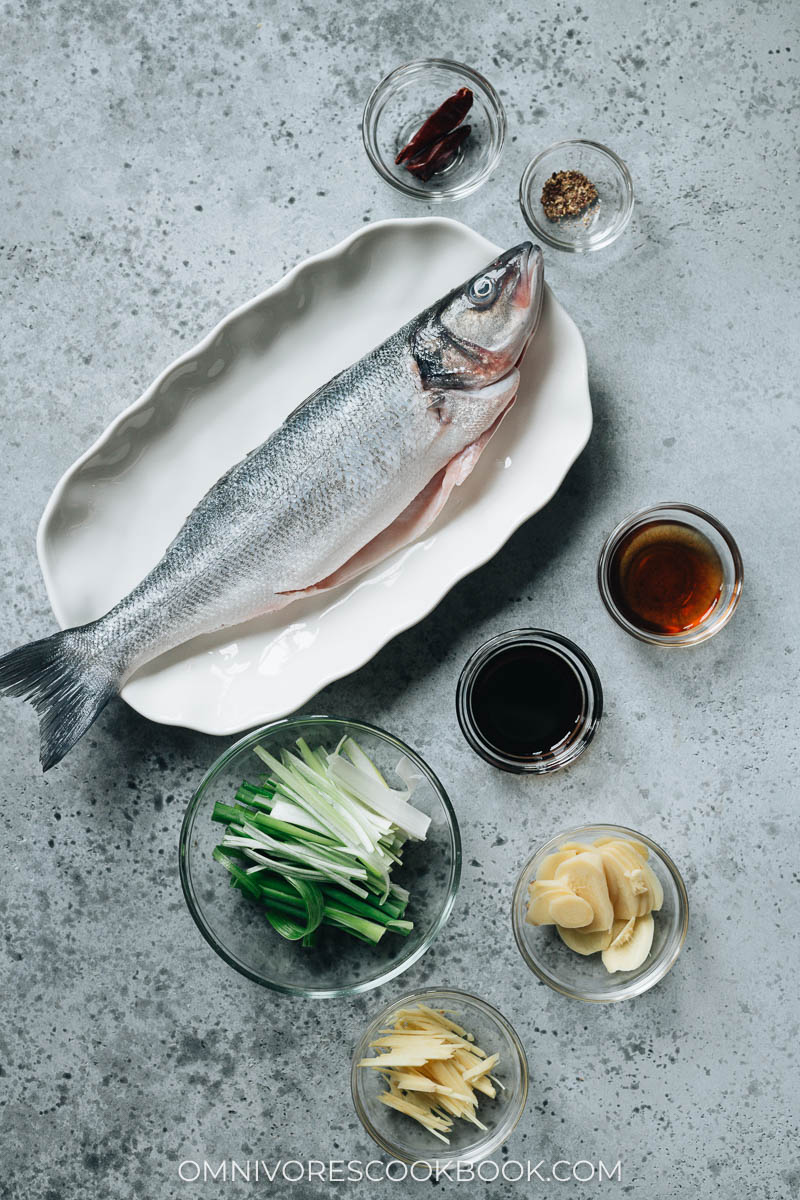
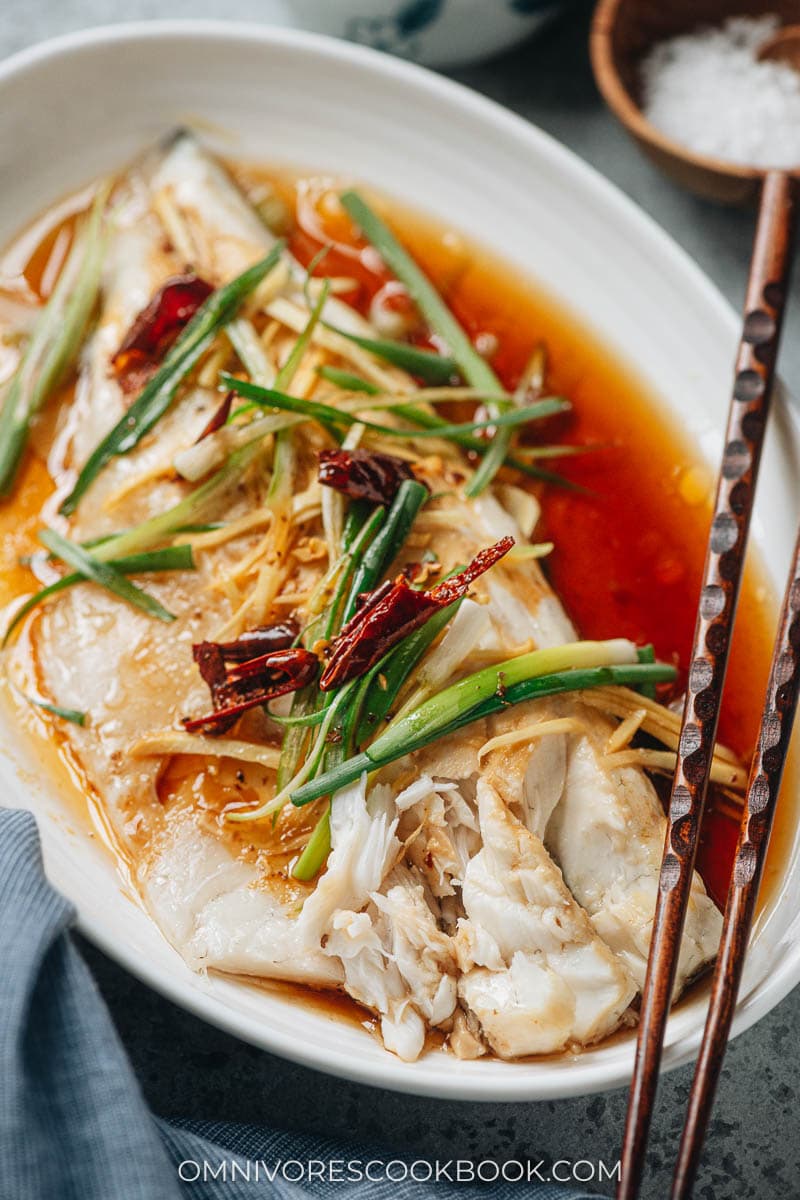
The dried chili pepper and Sichuan peppercorns create a very fragrant oil. When you pour the oil over the fish, it sizzles the aromatics and makes the dish extra fragrant.
How to set up the steamer
One of the biggest issues for making Chinese steamed fish is to find a steamer that is big enough to hold the whole fish.
The most convenient way is to use a large wok (at least 18”), a steamer rack, and an oval plate.
Alternatively, you can also use a large oval pot to replace the wok.
If you have a smaller steamer, you can also cut the whole fish in half and place the halves in a round dish.
And of course, you can also cook with a fish filet, which takes up less space.
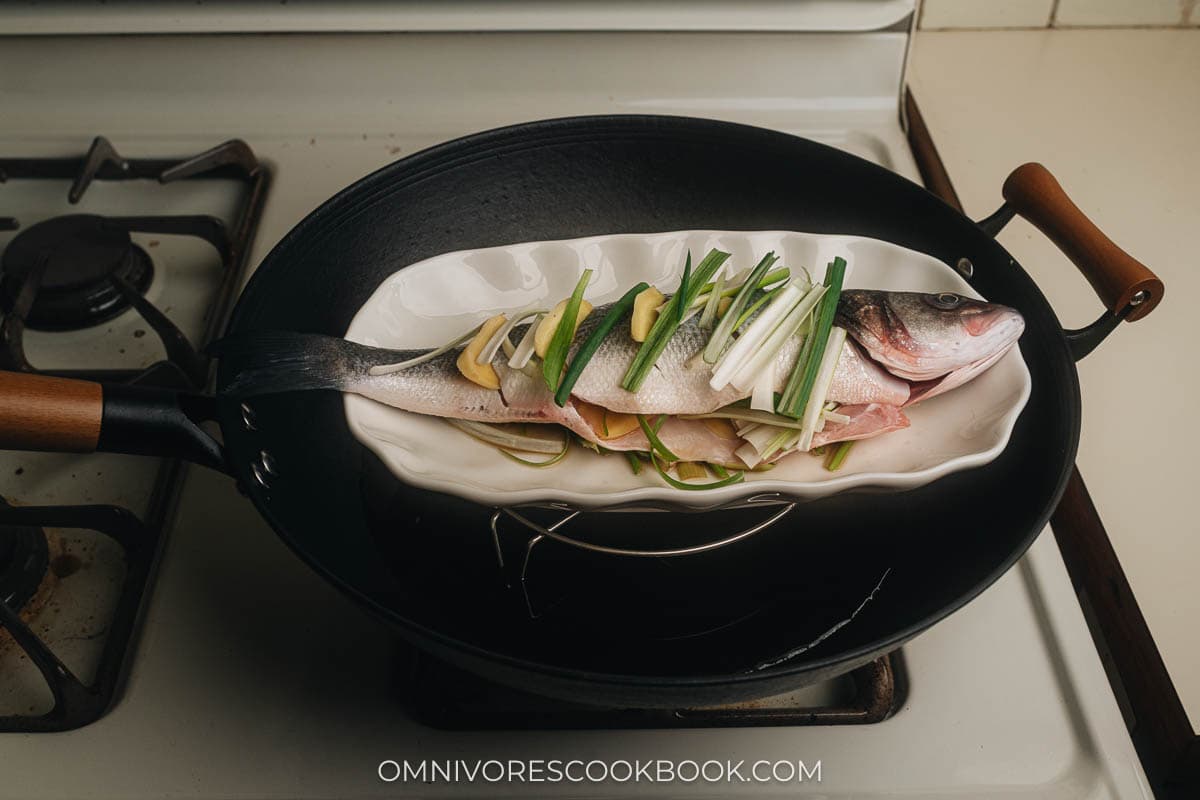
How to make Chinese steamed fish
Making Chinese steamed fish is quite easy and fast:
- Score the fish.
- Stuff ginger and green onion into the fish, and place extra on the top and bottom. Sprinkle with salt and drizzle with Shaoxing wine.
- Steam the fish until just cooked through.
- Remove the ginger and green onion from the top.
- Add julienned ginger and green onion to the fish.
- Heat up oil with chili pepper and Sichuan peppercorn.
- Pour the hot oil over the fish.
- Immediately drizzle with seasoned soy sauce.
The process is quite simple, yet you’d be surprised at how flavorful the fish is.
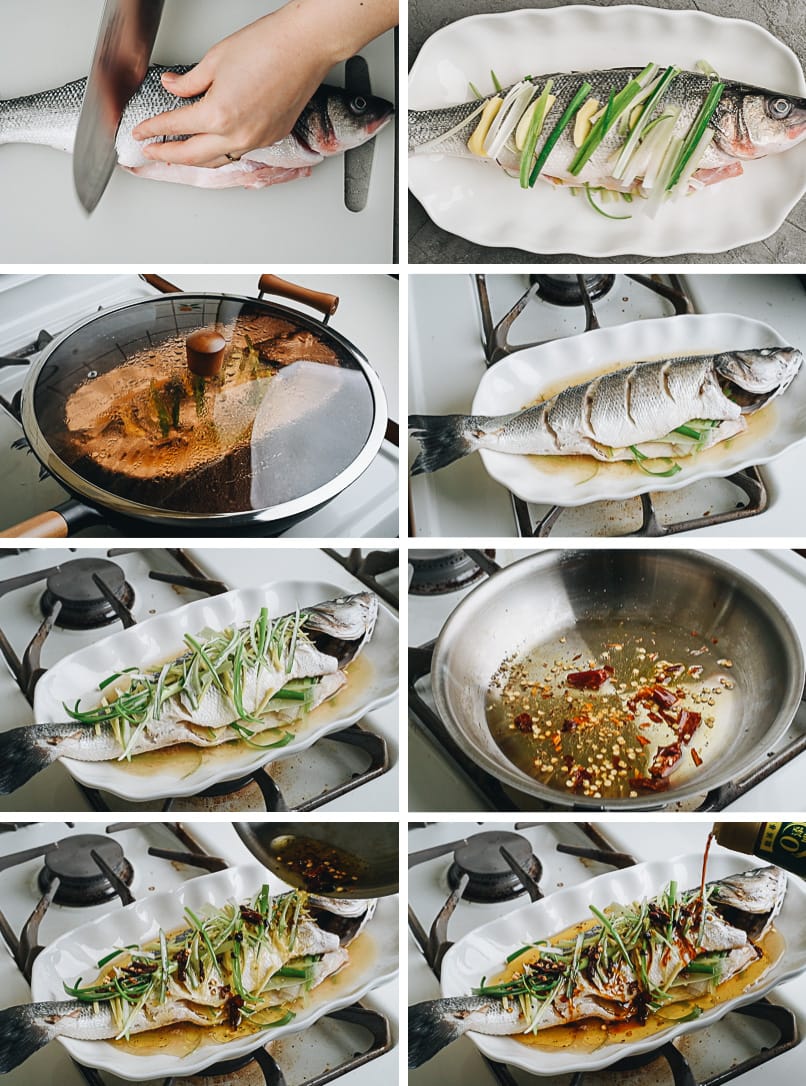
TIP – Do not overcook the fish
When you start to steam the fish, It is very important to keep the heat high, so the fish will be cooked in the shortest amount of time.
My 1.1 lb (500 g) branzino only took 5 minutes to cook through. Larger and thicker fish require more time. Fish filets usually require a bit more time to cook too, because the flesh is thicker than that of the whole fish. My 7.5 oz / 200 g branzino filet took 8 minutes to cook through.
Check the doneness of the fish after 5 minutes. You should be able to flake the meat easily. Stop steaming immediately when the fish is just cooked through.
Can I use fish filet instead of whole fish
Yes you can!
Although I always prefer to steam a whole fish, you can use fish filet and still get a great result.
Instead of stuffing the fish with aromatics, you can simply place the aromatics on the top and bottom of the fish.
And also remember that a fish filet might take longer to cook than a whole fish, since the flesh is a bit thicker.
I used a branzino filet in this recipe. But other white fish, such as flounder, tilapia, snapper and cod work very well too.
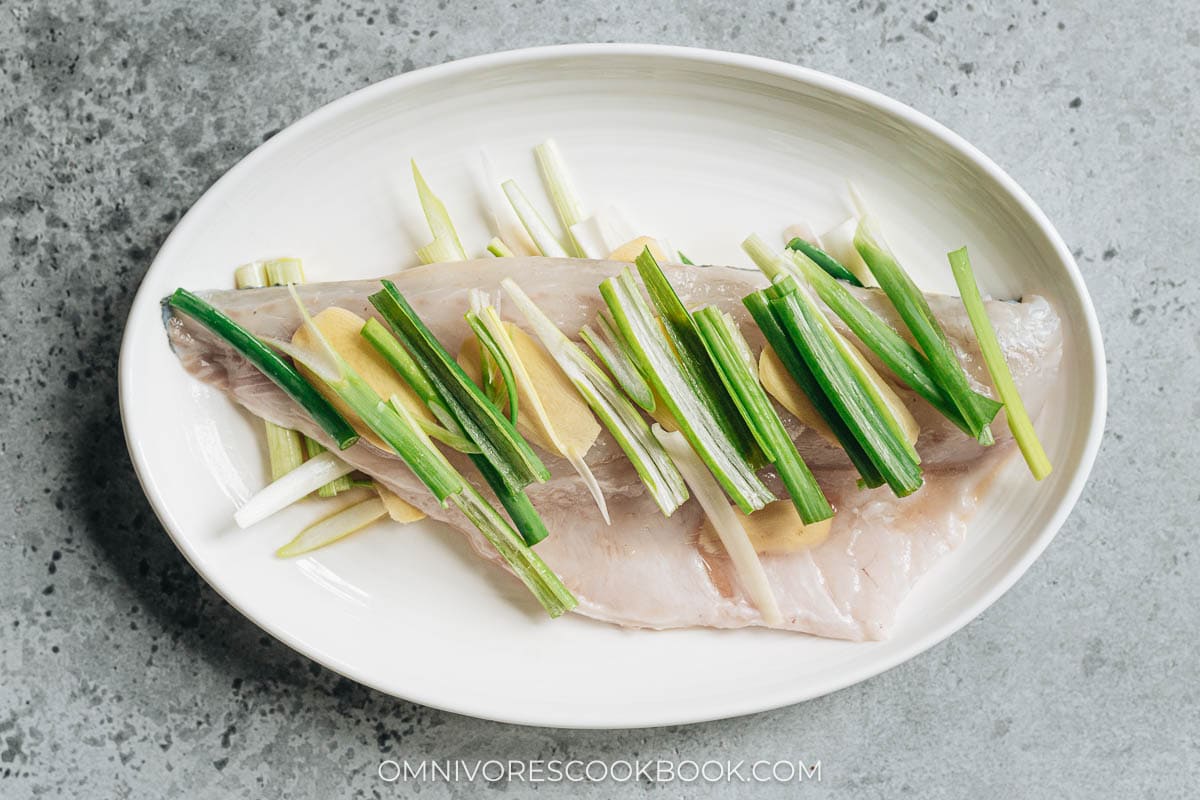
How to serve steamed whole fish
Chinese steamed fish is usually served as one of the main dishes during a multi-course meal. But since it’s quite an easy dish to prepare, you can also serve it as a main dish with white rice for dinner.
To select side dishes that go with steamed fish, I prefer lighter ones like cucumber salad, potato salad, stir fried pea shoots, and Chinese broccoli with oyster sauce. Or, you could go to my recipe index to browse for other choices for sides.
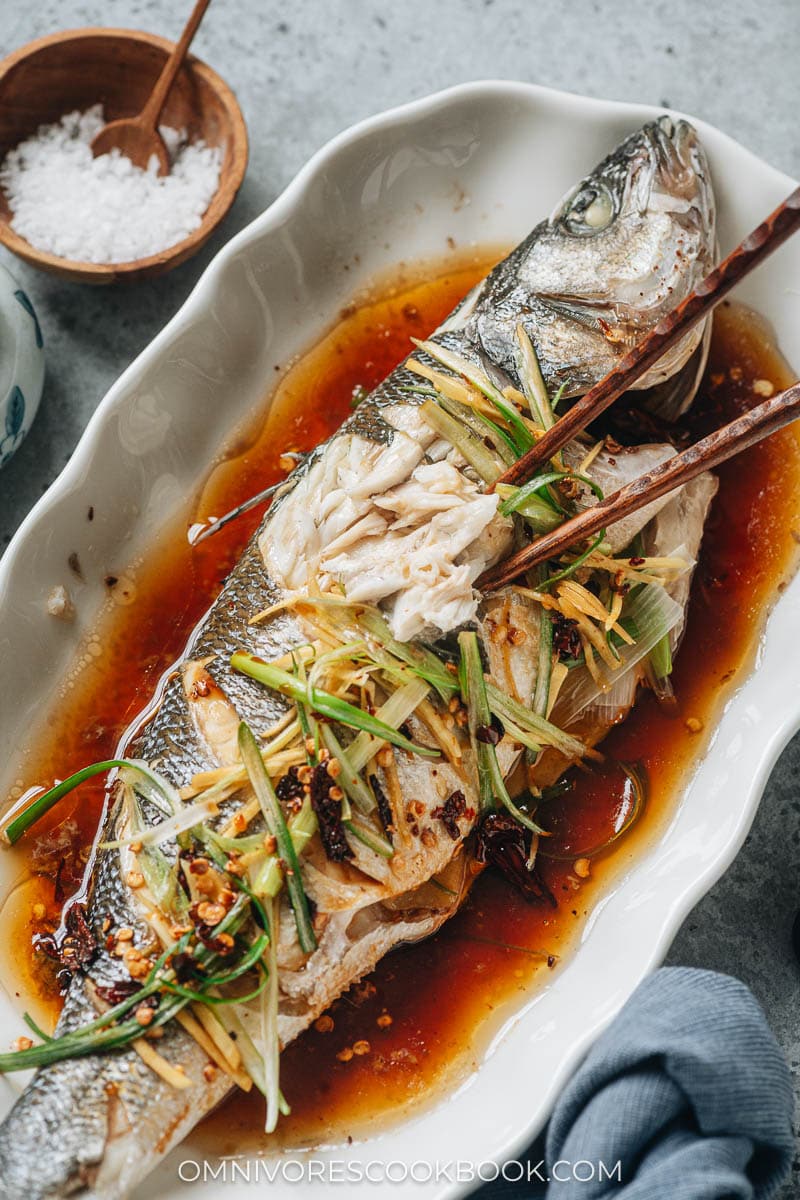
Chinese steamed whole fish tastes the best when it’s fresh off the stove. But if you happen to have any leftovers (very unlikely though!), you can either gently steam it or serve it cold. The fish will be at least a little overcooked, no matter how much you reheat it, so I usually prefer to eat the leftovers cold or at room temperature.
More Chinese New Year Recipes
- Pork and Chive Dumplings (猪肉韭菜水饺)
- Chinese Lion’s Head Pork Meatballs (狮子头)
- Buddha’s Delight (Jai, Chinese Vegetarian Stew)
- Chinese Scallion Pancakes (葱油饼)
- Chinese Hot Pot Guide (火锅)
Chinese Cooking Made Easy
Are you new to this website? This free email series is a great place to start. I’ll walk you through a few of my most popular recipes and show you how and why they work. You’ll quickly start to cook better Chinese food in your own kitchen.
Watch video
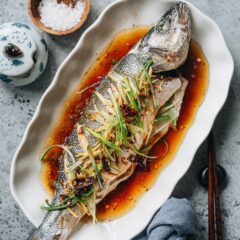
Chinese Steamed Fish (清蒸鱼)
Ingredients
- 1 small (about 1.1 lb / 500 g) head-on sea bass (or tilapia, flounder, or other white fish, scaled, gutted; OR white fish filet) (*Footnote 1)
- 1 1/2 pieces (thumb-sized) ginger , 1 thumb sliced, 1/2 thumb julienned
- 3 green onions , sliced into 2.5” (6 cm) long pieces
- 2 tablespoons Shaoxing wine
- 1 1/2 tablespoons peanut oil (or vegetable oil)
- 2 dried Chinese chili peppers
- 1/8 teaspoon ground Sichuan peppercorn (Optional but highly recommended)
- 2 tablespoons seasoned soy sauce for seafood (or 2 tablespoons regular soy sauce + 1 teaspoon sugar + 1/2 teaspoon chicken bouillon, gently heated in the microwave for easy mixing)
Instructions
- Before cooking, check if the fish is fully scaled by running your fingers from the tail of the fish to the head. Use kitchen shears to descale if needed. Wash the fish thoroughly with cold tap water and drain. Dry the fish with paper towels. Score the fish 3 to 4 times, 1” (2.5 cm) apart.
- Place a quarter of the green onions on a plate large enough to hold the entire fish. The green onions will hold the fish so it won’t stick to the plate when cooked.
- Stuff ginger slices and a quarter of the green onions (white part) into the cavity of the fish. Stuff the ginger slices into the scored parts. Pour the Shaoxing wine over the fish. Season very lightly with salt. Cover the fish with another quarter of the green onions. Let marinate for 10 minutes at room temperature while preparing the other ingredients, or in the fridge for half a day, until you’re ready to cook.
- In a large, deep skillet (or steamer or wok), add 1” (2.5 cm) of water and place a steaming track in the middle (Footnote 2). Place the plate of fish over the rack. Cover and bring water to a boil over high heat. When the steam starts to come out, cook, covered, over high heat for 5 to 8 minutes (*Footnote 3), until you can easily pull the flesh from the bone with a fork. Turn off the heat immediately.
- Carefully transfer the plate of the fish onto the kitchen counter. Use a pair of chopsticks to remove and discard the ginger and green onion from the top of the fish.
- Spread the remaining julienned ginger strips and green onions on top of the fish and set aside. Make sure the seasoned soy sauce is ready beside the fish.
- In a small skillet or saucepan, heat oil over medium-high heat. When the oil is warm, break chili peppers into 3 to 4 pieces and add them, with the ground Sichuan peppercorns, into the oil. Stir with a spatula until fragrant and the peppers are sizzling, about 30 seconds. Drizzle the hot oil over the fish. You should hear the sizzling of the oil when it touches the fish. Immediately pour the seasoned soy sauce onto the fish.
- Serve immediately. The fish won’t hold sauce very well, so make sure you dip the fish meat into the sauce from the plate as you eat. (see footnote 4).
Notes
- Before cooking, you should make sure you have a plate and a skillet (or a wok) that are large enough to hold the fish. If not, you should cut the fish in two such that each piece is half the original length, so it can fit into the skillet.
- If you don’t have a steaming rack, you could place a pair of wooden chopsticks, 4 inches apart, onto the bottom of a skillet as “feet” to hold the plate. You only need something to hold the plate off the bottom of the skillet and to make sure the water won’t spill onto the plate when steaming the fish.
- When I cooked a 1.1 lb (500 g) whole branzino, it took me 5 minutes to cook it through. A branzino filet (7.5 oz / 200 g) took 8 minutes to cook, because the flesh was thicker than that of the whole fish.
- Although you can add the seasoned soy sauce afterwards, the flavor will be slightly different from the way it tastes when poured immediately following the hot oil.
Nutrition

Did you make this recipe?
I’d love to hear how it turned out for you! Please take a moment to leave a 5-star rating ⭐️ and share your thoughts in the comments further down the page. It really helps others discover the recipe too.

tio
Love it, can also use microwave to steam fish.
Louise Samson
Absolutely delicious! I tried it with haddock and it was a feast!
Bianca
I really like this recipe. I would also recommend using honey and garlic with lemon and butter. I have cooked this dish today, it tastes perfect.
Carole
Delicious!~Fantastic I served with jasmine rice and sauteed eggplant!
Divya Annamraju
I have made this dish 3 times and including for a discerning cousin who was visiting. It is purely delicious and has greatly increased my appreciation for Chinese cooking techniques. Cant wait to make for a friend who’s an excellent cook!
Naiem Soliman saad
Thank you it tasted very good.
Hilarious Username
I used to date a guy who made fish this way, and it was AMAZING!! I’m so glad I found this recipe, so I can make this…. I miss it so much. I miss his cooking way more than the man himself, for sure.
I’m going to leave out the peppers, though; I’m a spice wuss. What could I substitute for the peppercorns and hot peppers in the oil? Maybe more ginger and a few lemon slices, or just straight-up, plain oil? I think that’s how he used to do it, to accommodate my sensitive, bland, white girl palate.
tio
try using heated sesame oil instead?
Jenny
Hi, my mom use to make steamed fish all the time. What fish do you usually get besides flounder that doesn’t have too much bones and great for steaming? This is my biggest dilemma even I’m at 99 Ranch. Is Goby a good option? Also my mom prepares it somewhat differently. She adds the soy sauce and other sauce to the hot oil and pour all together onto the fish. Does that impact the taste?
VI
Another keeper, delicious and fun to make! I need to get better at getting the final sizzling thing with less oil though, I had to cheat a bit and use more 😉
Ernest
Great recipe, delicious and simple. I love the way the oil sizzled on the fish near the end. I used sea bream which worked well. I think next time I will use sea bass, a slightly thinner fish.
Maggie
Hi Ernest, I’m glad to hear you like the recipe! Yes, a smaller and thinner fish always works better. A sea bass is perfect for cooking steamed fish 🙂
Roger
Hi There, What do you mean by seasoned soy sauce? Is this pe bought or do you make it up yourself from regular bought soy sauce? Love your site, truely inspiring., Thank you.
Maggie
Hi Roger, it is a type of soy sauce I bought while I was still living in China. It is slightly sweet, designed for seasoning seafood.
If you don’t have it, you can use one part of regular soy sauce plus one part oyster sauce instead.
Christine | No Gojis No Glory
Maggie, I’m loving this dish! I’ve never made whole fish before, mostly because it’s so intimidating. What do you mean by “live fish”? One that’s alive right before you buy it? I can’t imagine actually taking home a live fish to prepare
Maggie
Yes, by live fish I mean the ones that are alive right before you buy them. In China we usually let the butcher to clean up the fish before taking it home. But I know in rural area, or for people who really care about the freshness of the fish, they will bring a live fish home to gut it by themselves! I should try that one day and upload the slaughter to YouTube… Sorry if it sounds too bloody!
Kelly – Life Made Sweeter
Love this post Maggie! Steamed whole fish is one of my favorite dishes whenever we go out to a restaurant but I have never made it at home. This tutorial is awesome! Can’t wait to try making this 🙂 Pinning!
Maggie
Thanks for sharing Kelly! This one is very easy to make, but you gonna get very fishy hands after dealing with the fish 😉 And yes, it’s one of my favorite too!
Sophie Hawley
Wow, this is so beautifully photographed, and I love your attention to the details of the flavors! A very comprehensive guide 🙂
Maggie
Thanks Sophie! It took me some time to figure out how to cook this dish to bring out the best flavor, so I shared the info. as thoroughly as I could! Glad you found it helpful! 🙂
mira
This fish looks amazing and I really want to try it. Never had steamed fish before, but reading your instructions it seems pretty simple. Pinning!
Maggie
Thanks Mira! The steamed is quite unique outside of China, but it’s so easy to make at home. Hope you enjoy the recipe 🙂
Bonnie Eng
Ah, I looove steamed fish. My hubby doesn’t though, which is really frustrating because I don’t think I’ve eaten nearly as much as I used to after getting married! This recipe looks too delicious to pass up…will plan on making this when he is out of the house for a moment! 😉
Nagi@RecipeTin Eats
Hi Maggie, I love this way of preparing fish! It is my favourite way for whole fish. I love your blog! I can’t believe I haven’t come across you before 🙂 Subscribing now so I can make sure I don’t miss a post! I love finding great Asian blogs. Though my blog is not strictly Asian food, it is by far my favourite cuisine – every single country!